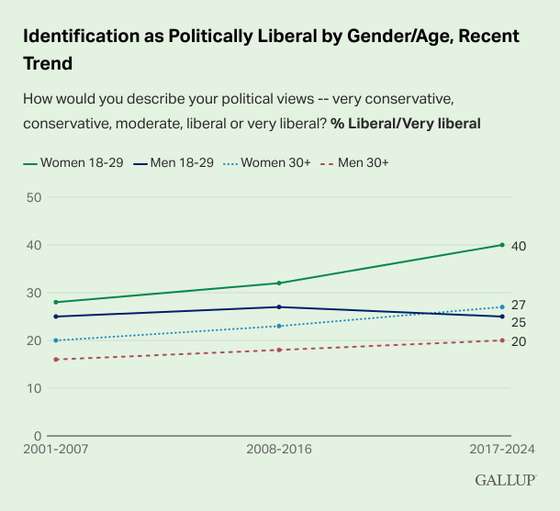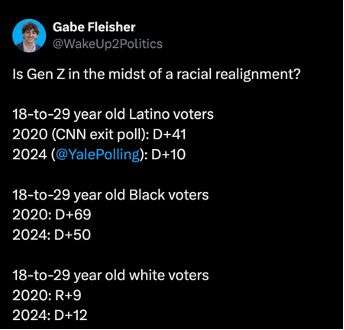There are three factors that would have raised the political consciousness of many women, especially younger women, which would have led to greater female politicization and translated into strong support for Harris.
1 Racial depolarization
In 2020, Ismail K. White and Chryl N. Laird attempted to explain why support for the Democratic Party is so strong among African Americans, even though they tend to be more conservative on moral issues than the party’s progressive line. In Strong Democrats: How Social Forces Shape Black Political BehaviorResearchers analyzed how the transfer of votes from Republicans to Democrats, which culminated in the civil rights movement in the 1960s, led to the consolidation of the idea that “supporting the Democratic Party came to be understood as something that one “he does when he is black.”
Half a century later, this identification would continue to be the result of a “social coercion of racial origin,” which conditions individual decisions and maintains social pressure towards the acceptable norm. The reasons are historical and related to identity: being an ethnic minority group with a past of slavery, this social norm would strengthen the political power of the group, which creates incentives to remain politically united.
This would have been the reason why black electoral support for the last Democratic candidates (Obama, Clinton, Biden) was greater than 90% and why recent polls, which reveal lower support for Kamala Harris, were received with so much surprise. The gap is especially visible among men, and also occurs with the Hispanic vote (although the perspective is different there, since the initial support base has never been higher). In analyzing the new data, some commentators have spoken of “racial depolarization,” which would be particularly evident among 18- to 29-year-olds, according to the Yale Youth Pole:
For those who study identity thinking and, in particular, critical race theory, this is a curious phenomenon: in the endour political positioning is not simply the result of our racial identity. It is even possible that “racialized” voters have different political perspectives, social interests and moral values within the group… This is good news, since these trends not only reintroduce the sense of political pluralism, rejecting the idea that all blacks They are behaving and thinking in the same way, in addition to rejecting the paternalism inherent in identity thinking.
In fact, White and Laird’s hypothesis seems to be proven when we see Barack Obama’s pressure on black men to vote for Kamala; and, from this perspective, the campaign “What happens in the stand, stays in the stand”, with the voice of Julia Roberts, takes on a new meaning. But both Obama’s and Julia’s words reveal that the polarization lies elsewhere.
2 Pat Schroeder’s Lesson
From the moment Kamala Harris was “elected” as the Democratic candidate, there was some expectation about whether her campaign would resort to the “first woman president” argument as an electoral strategy. This path had failed Hillary Clinton (although it is difficult to say if it was the worst mistake of her campaign) and in many feminist circles what Pat Schroeder had said in 2008 continued to resonate:
“I thought about running for president in 1988. What a project. After a few very emotional months, I realized that the United States was not man enough choose a woman.”
If Schroeder’s lesson remained valid, it was necessary to proceed with caution: how to mobilize the female electorate without awakening patriarchal fears? The cultural struggles that mark current politics offered Kamala a way out: her campaign would focus on the issue of “reproductive rights” and, in particular, abortion, considered consensual among progressives (the second episode of the podcast The donkey and the elephant is dedicated to the topic).
This is a subtle strategy that allows us to appeal directly to the female vote without falling into Clinton’s mistake of making the campaign a matter of electing a woman. But it also allows us to use one of the most divisive issues in North American society – abortion – to mobilize the progressive electorate (the issue functions as a kind of dog whistle political). The issue would no longer be electing a woman, but rather protecting women from a candidate perceived as a threat – and with this message a set of ideas could be implied, such as patriarchy, white privilege or structural discrimination, calming down women. more radical wings of the party. party.
For journalist Matthew Yglesias, it is a winning strategy, but one that, like all strategies, involves paying a price: in this case, alienating voters from more conservative communities, such as Hispanics and African Americans (perhaps even Muslims, where). the weight of religion is stronger.
However, there is a greater risk that deserves to be considered: that this strategy reinforces a trend that has been analyzed over the last year and that reveals a very pronounced political divergence of women towards the left, with strong politicization, especially among women. younger. generations. That’s what it’s called in English. gender gap.
3 The political divergence of women
The first data were presented at the beginning of this year and the most recent studies have confirmed the trend: according to Gallup, in the last two decades women have been identifying more as liberals (left), but it is specifically in the Es in the age range between 18 and 29 years where this trend is most accentuated, creating a divergence with men of the same age that has never been greater.

The journalist Claire Cain Miller has dedicated herself to the issue of the “gender division” (we will return to it) and points out three factors that contributed to the female divergence: the first resulted from the electoral dispute that pitted Hillary Clinton against Donald Trump, and the first resulted from the electoral dispute between Hillary Clinton and Donald Trump, and which gave rise to the Women’s March in January 2017; the second arises from the #metoo movement, which that same year gained global publicity; and the third concerns the reversal of the Wade decision. vs. Roe, which provoked a very strong reaction from various groups, who understood the decision as an attack on women’s rights.
These three factors would have raised the political consciousness of many women, particularly younger women, which would have led to greater female politicization and translated into strong support for Harris. And if we consider that women participate more in voting (men tend to vote less), the strategy may, in fact, be effective… at least in the short term.
In the long term, the idea of fueling political divergence between men and women could prove deeply problematic. After all, promoting such deep social divisions and destroying the cohesion of the social fabric, which is fundamental for democratic functioning, can generate wounds that are difficult to heal and even more polarized reactions.
Source: Observadora
